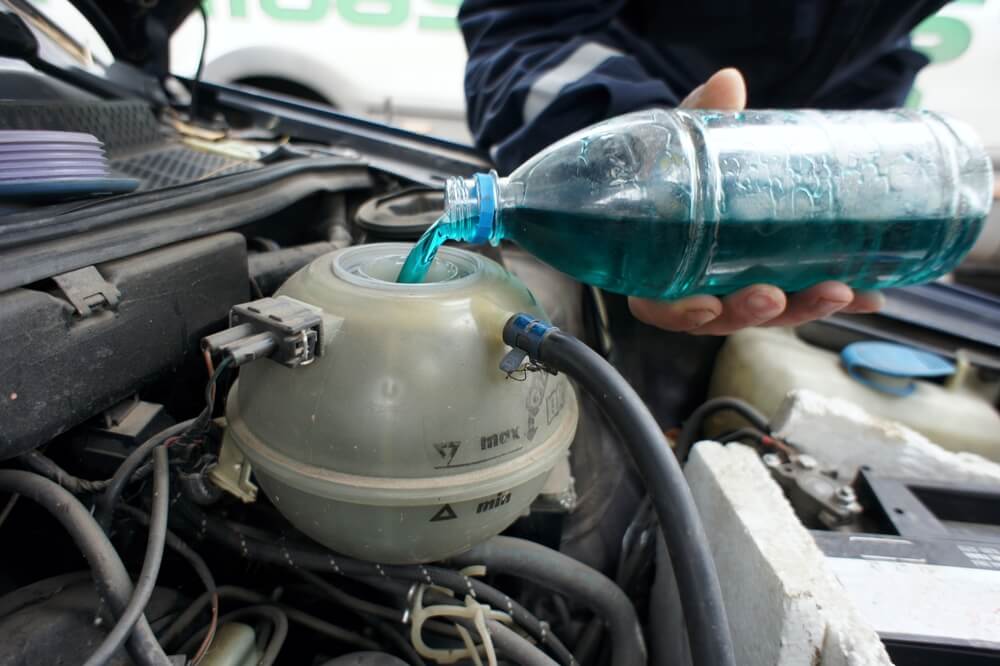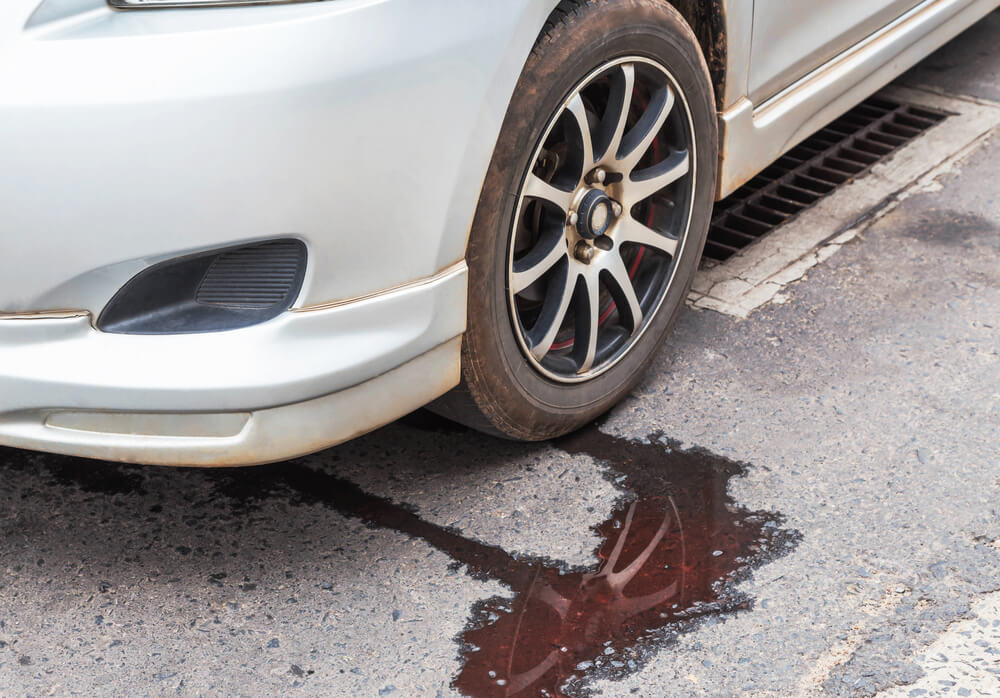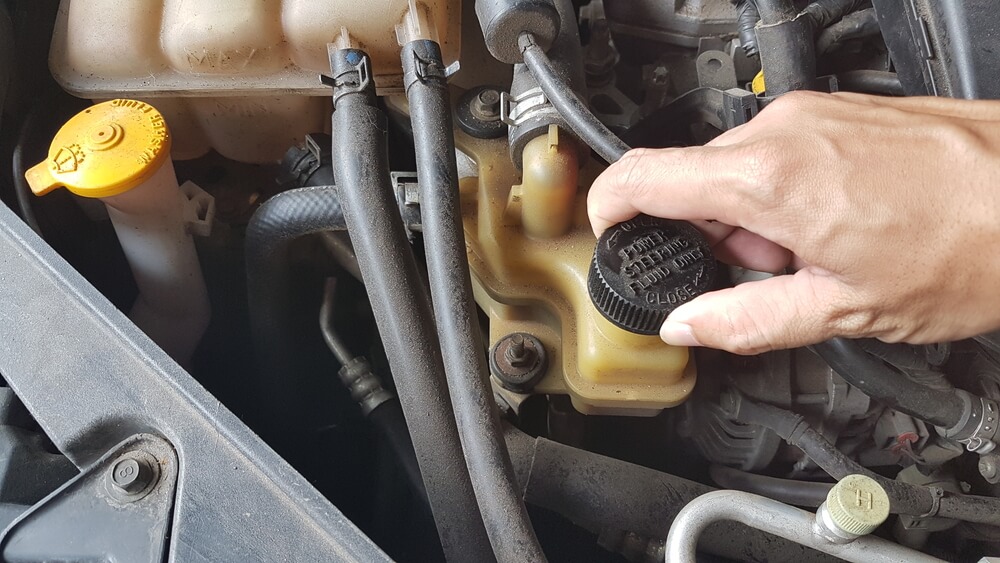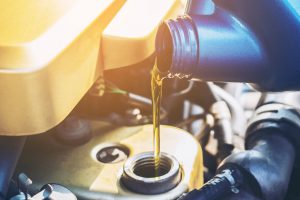As you approach your parking spot, you notice a suspicious liquid seeping from beneath your car. Your heart drops. What is it? What did I do? How much is this going to cost? Will it crank? You kneel on the pavement, staring at the puddle of unidentified ooze. When a vehicle springs a leak, its driver usually assumes the worst. While some automotive fluid leaks are serious, many are really no big deal and can be fixed by even the most inept car owner.
If you notice a leak, it is more than likely one of the types of auto fluids listed below. Here are some tips to help you identify the mystery leak and instructions on how to stop the drip.
How to Identify and Handle Auto Fluid Loss
Here’s how to identify and handle fluid leaking from your car.
- 1
Engine oil is the most common type of fluid leak. If the puddle of liquid is towards the front of your vehicle, its source is probable the engine. Dip your finger or a piece of paper towel into the liquid. If it is engine oil, the fluid will be brown or black, slick to the touch, and have a slightly burnt odor. Look underneath your vehicle to ensure that the oil pan plug is properly in place and that the oil filter is secured. If neither of these parts are the culprit, you may need to take your vehicle to a mechanic or a quick oil change garage to have the oil pan inspected. A cracked oil pan can cause oil to leak, as can faulty engine valves. Until then, add a quart of the appropriate engine oil to replace any that has been lost because of the leak.
- 2
Another common fluid to leak from vehicles is antifreeze. Like engine oil, the source of an antifreeze leak is usually in the front part of your vehicle, close to the engine.
Mind that antifreeze is extremely toxic for people and pets![radiator leak]()
Antifreeze may also leak from your exhaust pipe at the tail end of your car. The consistency of antifreeze is thinner than oil but slightly thicker than water. It is usually red or green in color. The easiest identifying characteristic of antifreeze is that it smells sweet. Be careful not to make contact with your mouth or eyes if you need to sniff the fluid to determine that it is antifreeze. If you notice this type of auto fluid leaking from your vehicle, take it to your mechanic immediately. Leaking antifreeze can be caused by radiator or water pump malfunction and may eventually lead to further damage to your engine.
- 3
Transmission fluid leaks will appear closer to the center of the vehicle. Transmission fluid is sometimes difficult to distinguish from oil; however, this fluid has more of a reddish color and smells similar to gasoline. If you determine that your leak is transmission fluid, take your vehicle to a mechanic as soon as possible. The transmission fluid may need to be replaced or the leak could be caused by a more serious engine problem. Drive your vehicle as little as possible until you can get it to the shop.
- 4
Power steering fluid leaks are usually found somewhere under the front half of your car.
Another sign of low power steering fluid is the squealing noise when the wheels turn![power steering fluid]()
Power steering fluid is slick like engine oil but slightly thinner. If you think that your car is leaking power steering fluid, allow a mechanic to address the problem immediately. Leaking power steering fluid may result in the sudden loss of your power steering, a significant safety hazard.
- 5
Brake fluid is sometimes difficult to distinguish from power steering fluid as it has a similar texture and color. Brake fluid leaks can be found anywhere underneath your vehicle. This leak should also be professionally addressed as soon as possible. The loss of braking power could result in a serious accident.
- 6
Perhaps the easiest to identify of any automotive fluid leak, gasoline leaks are also the most problematic. Faulty fuel injectors or fuel lines often cause gasoline to leak from your vehicle. Not only are you losing money, fuel leaks are often caused by major problems that should be addressed by a mechanic
- 7
Windshield wiper fluid is the one leaking liquid that does not affect the operation of your vehicle. This leak will appear towards the front of your vehicle, is the consistency of water, and will often be brightly colored.
Refilling windshield wiper fluid is a very easy 2-minute job![windshield fluid reservoir]()
Check the windshield wiper fluid reservoir to ensure that the cap is properly in place and refill any lost fluid.
If you notice that your vehicle is leaking fluid, first make sure that the liquid is kept away from any pets or small children. If you think that someone or something might have consumed any auto fluid before you realized you had a leak, call Poison Control immediately. Properly dispose of any rags that you use to clean-up the fluid.
If you need to visualize what you have read about, this is a video guide for expert leak identifying:
Knowing how to identify fluid loss is an important skill for any car owner. While some leaks can be addressed at home, others denote potentially serious problems and need to be inspected by a professional. Routinely check for possible leaks and always be aware of any puddles or drizzles around your normal parking spaces.








